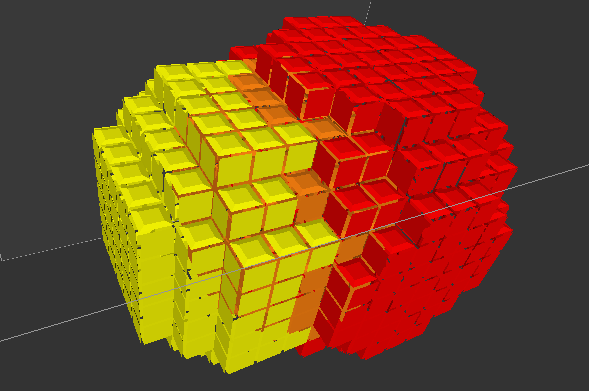Loading...
Searching...
No Matches
topology/frontierAndBoundary.cpp
Frontiers and boundary of two intersecting balls. The first ball is labelled 1 (red), the second 2 (yellow), their intersection 3 (orange). The frontier between 1 and 0 is displayed in red, the frontier between 2 and 0 is displayed in yellow, the boundary of region 3 is displayed in orange.

#include <iostream>
#include "DGtal/helpers/StdDefs.h"
#include "DGtal/io/readers/VolReader.h"
#include "DGtal/io/viewers/PolyscopeViewer.h"
#include "DGtal/io/Color.h"
#include "DGtal/io/colormaps/HueShadeColorMap.h"
#include "DGtal/images/ImageSelector.h"
#include "DGtal/images/imagesSetsUtils/SetFromImage.h"
#include "DGtal/shapes/implicit/ImplicitBall.h"
#include "DGtal/shapes/GaussDigitizer.h"
#include "DGtal/shapes/Shapes.h"
#include "DGtal/topology/DigitalSurface.h"
#include "DGtal/topology/ExplicitDigitalSurface.h"
#include "DGtal/topology/helpers/FrontierPredicate.h"
#include "DGtal/topology/helpers/BoundaryPredicate.h"
using namespace std;
using namespace DGtal;
using namespace Z3i;
{
Point c1( 2, 0, 0 );
int radius1 = 6;
EuclideanShape ball1( c1, radius1 ); // ball r=6
DigitalShape shape1;
shape1.attach( ball1 );
shape1.init( RealPoint( -10.0, -10.0, -10.0 ),
RealPoint( 10.0, 10.0, 10.0 ), 1.0 );
Point c2( -2, 0, 0 );
int radius2 = 5;
EuclideanShape ball2( c2, radius2 ); // ball r=6
DigitalShape shape2;
shape2.attach( ball2 );
shape2.init( RealPoint( -10.0, -10.0, -10.0 ),
RealPoint( 10.0, 10.0, 10.0 ), 1.0 );
std::cerr << std::endl;
it != it_end; ++it )
{
DGtal::uint8_t label = shape1( *it ) ? 1 : 0;
label += shape2( *it ) ? 2 : 0;
image.setValue( *it, label );
std::cerr << (int) image( *it );
}
std::cerr << std::endl;
if (!space_ok)
{
return 2;
}
trace.endBlock();
trace.beginBlock( "Set up digital surface." );
MySurfelAdjacency surfAdj( true ); // interior in all directions.
typedef ExplicitDigitalSurface<KSpace,BSurfelPredicate> BoundaryContainer;
typedef DigitalSurface<BoundaryContainer> Boundary;
// frontier between label 1 and 0 (connected part containing bel10)
Frontier frontier10 =
new FrontierContainer( K, surfPredicate10, surfAdj, bel10 );
// frontier between label 2 and 0 (connected part containing bel20)
Frontier frontier20 =
new FrontierContainer( K, surfPredicate20, surfAdj, bel20 );
// boundary of label 3 (connected part containing bel32)
Boundary boundary3 =
new BoundaryContainer( K, surfPredicate3, surfAdj, bel32 );
trace.endBlock();
trace.beginBlock( "Displaying surface in PolyscopeViewer." );
PolyscopeViewer<> viewer;
viewer << domain;
Cell dummy;
// Display frontier between 1 and 0.
unsigned int nbSurfels10 = 0;
viewer << Color::Red;
for ( Frontier::ConstIterator
it = frontier10.begin(), it_end = frontier10.end();
it != it_end; ++it, ++nbSurfels10 )
viewer << *it;
// Display frontier between 2 and 0.
unsigned int nbSurfels20 = 0;
viewer << Color::Yellow;
for ( Frontier::ConstIterator
it = frontier20.begin(), it_end = frontier20.end();
it != it_end; ++it, ++nbSurfels20 )
viewer << *it;
// Display boundary of 3.
unsigned int nbSurfels3 = 0;
viewer << Color( 255, 130, 15 );
for ( Boundary::ConstIterator
it = boundary3.begin(), it_end = boundary3.end();
it != it_end; ++it, ++nbSurfels3 )
viewer << *it;
<< ", nbSurfels20 = " << nbSurfels20
<< ", nbSurfels3 = " << nbSurfels3 << std::endl;
trace.endBlock();
viewer.show();
return 0;
}
Aim: Represents a set of n-1-cells in a nD space, together with adjacency relation between these cell...
Definition DigitalSurface.h:140
Aim: A model of CDigitalSurfaceContainer which defines the digital surface as connected surfels....
Definition ExplicitDigitalSurface.h:82
Aim: A class for computing the Gauss digitization of some Euclidean shape, i.e. its intersection with...
Definition GaussDigitizer.h:80
Aim: model of CEuclideanOrientedShape and CEuclideanBoundedShape concepts to create a ball in nD....
Definition ImplicitBall.h:65
Definition PolyscopeViewer.h:56
Aim: Represent adjacencies between surfel elements, telling if it follows an interior to exterior ord...
Definition SurfelAdjacency.h:66
void beginBlock(const std::string &keyword="")
std::ostream & error()
std::ostream & info()
double endBlock()
Aim: The predicate on surfels that represents the frontier between a region and its complementary in ...
Definition BoundaryPredicate.h:70
Aim: The predicate on surfels that represents the frontier between two regions in an image....
Definition FrontierPredicate.h:68
Definition testClone2.cpp:346
DGtal is the top-level namespace which contains all DGtal functions and types.
Definition ClosedIntegerHalfPlane.h:49
STL namespace.
Image image(domain)
ImageContainerBySTLVector< Domain, Value > Image
Definition testSimpleRandomAccessRangeFromPoint.cpp:45